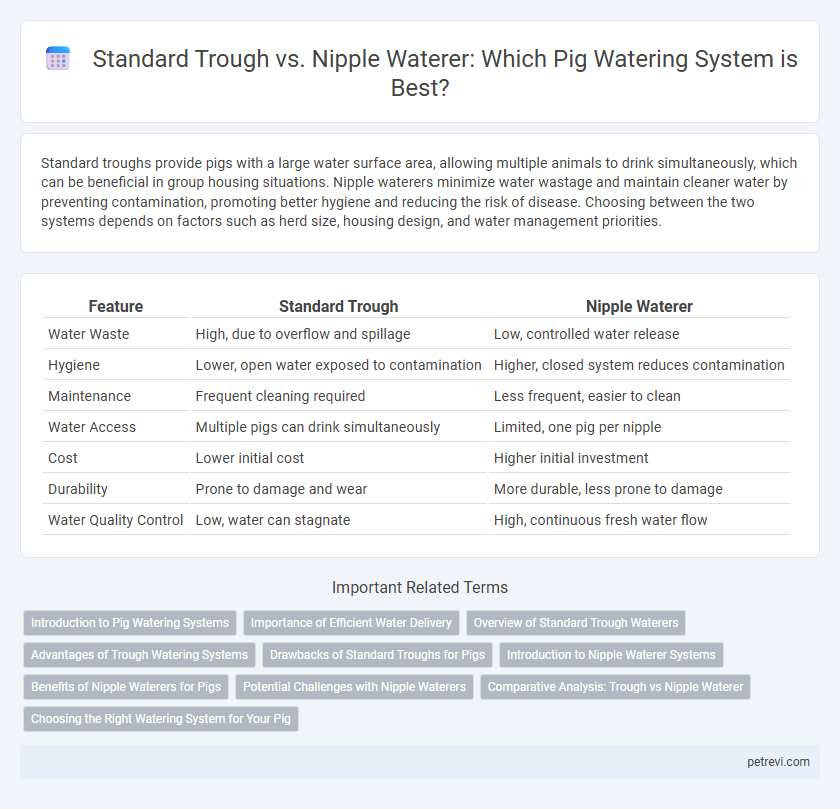Standard troughs provide pigs with a large water surface area, allowing multiple animals to drink simultaneously, which can be beneficial in group housing situations. Nipple waterers minimize water wastage and maintain cleaner water by preventing contamination, promoting better hygiene and reducing the risk of disease. Choosing between the two systems depends on factors such as herd size, housing design, and water management priorities.
Table of Comparison
| Feature | Standard Trough | Nipple Waterer |
|---|---|---|
| Water Waste | High, due to overflow and spillage | Low, controlled water release |
| Hygiene | Lower, open water exposed to contamination | Higher, closed system reduces contamination |
| Maintenance | Frequent cleaning required | Less frequent, easier to clean |
| Water Access | Multiple pigs can drink simultaneously | Limited, one pig per nipple |
| Cost | Lower initial cost | Higher initial investment |
| Durability | Prone to damage and wear | More durable, less prone to damage |
| Water Quality Control | Low, water can stagnate | High, continuous fresh water flow |
Introduction to Pig Watering Systems
Pig watering systems are essential for maintaining proper hydration and health in swine production. Standard troughs provide a simple, gravity-fed water source but can lead to water contamination and increased waste. Nipple waterers offer a more hygienic and efficient solution, delivering clean water on demand and reducing spillage.
Importance of Efficient Water Delivery
Efficient water delivery in pig watering systems is critical for maintaining optimal hydration and promoting healthy growth rates. Standard troughs can lead to water wastage due to spillage and contamination, whereas nipple waterers ensure cleaner, more controlled water access, reducing disease risk and improving water conservation. Choosing nipple waterers enhances hygiene standards and minimizes labor for cleaning, supporting overall farm productivity.
Overview of Standard Trough Waterers
Standard trough waterers for pigs provide a simple, cost-effective method for water delivery, featuring a large basin that allows multiple pigs to drink simultaneously. These troughs require regular cleaning to prevent algae growth and contamination, ensuring optimal water quality and pig health. Compared to nipple waterers, troughs can lead to higher water wastage but offer easier access, especially for larger pigs or during group feeding.
Advantages of Trough Watering Systems
Trough watering systems for pigs offer consistent water availability and accommodate multiple animals simultaneously, reducing competition and stress. They are easier to clean and maintain compared to nipple waterers, helping to ensure better hygiene and water quality. Troughs also allow for easier monitoring of water consumption, which is crucial for managing pig health and growth efficiently.
Drawbacks of Standard Troughs for Pigs
Standard troughs for pig watering systems often lead to higher water contamination risks due to stagnant water and pig waste accumulation. These troughs require frequent cleaning to prevent bacterial growth and waterborne diseases, increasing labor costs and maintenance time. Additionally, water spillage from troughs can result in wet, unsanitary pen conditions, ultimately affecting pig health and overall farm hygiene.
Introduction to Nipple Waterer Systems
Nipple waterer systems for pigs provide a clean, efficient, and hygienic alternative to standard trough watering, reducing water spillage and contamination. These systems deliver water directly to the pigs, minimizing waste and maintaining better pen sanitation. The controlled flow of nipple waterers supports consistent hydration, promoting healthier growth and overall welfare in pig farming operations.
Benefits of Nipple Waterers for Pigs
Nipple waterers provide pigs with clean, fresh water, reducing contamination and water waste compared to standard troughs. They promote better hygiene by minimizing standing water, which lowers the risk of bacterial growth and disease transmission. Their efficient design also encourages proper hydration, enhancing overall pig health and growth performance.
Potential Challenges with Nipple Waterers
Nipple waterers for pig watering systems offer precise water delivery but can face issues such as clogging due to mineral deposits or debris, leading to reduced flow and potential dehydration risk. Maintenance challenges include regular cleaning and replacement to ensure proper functionality and hygiene. Additionally, younger piglets may struggle to activate the nipple mechanism, requiring supplemental water sources or training to guarantee adequate hydration.
Comparative Analysis: Trough vs Nipple Waterer
Standard troughs offer pigs easy access to water and are cost-effective for large groups but risk contamination and spillage, leading to higher water wastage. Nipple waterers provide cleaner water delivery, reduce waste by limiting spillage, and promote hygiene, though installation and maintenance costs are higher. In terms of efficiency, nipple waterers outperform troughs by minimizing water loss and maintaining water quality, essential for pig health and farm sustainability.
Choosing the Right Watering System for Your Pig
Choosing the right watering system for your pig depends on factors like hygiene, water wastage, and ease of access. Standard troughs provide ample water but are prone to contamination and require regular cleaning, while nipple waterers offer cleaner, fresher water and reduce spillage, promoting better health. Evaluate your pig housing setup and maintenance capacity to select a system that ensures consistent hydration and supports overall pig welfare.
Standard trough vs Nipple waterer for Pig watering system Infographic

 petrevi.com
petrevi.com